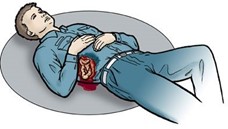The nurse is caring for a client with a diagnosis of a ruptured appendix who underwent an emergency exploratory laparotomy with appendectomy 48 hours ago.
The 55-year-old client was admitted through the Emergency Department (ED) with fever, chills, nausea, and diffuse abdominal pain. Computed tomography (CT) of the abdomen confirmed a ruptured appendix with widespread inflammation. The client is 6'1" (193.04 cm) tall and weighs 260 lbs (117.93 kg). The client is obese with a BMI of 31.6 kg/m2. The client underwent an immediate exploratory laparotomy with appendectomy. The wound was not closed and was packed with sterile gauze.
The client's past medical history includes gastric reflux disease (GERD), hypertension, and type 2 diabetes mellitus. The client has no known drug allergies (NKDA). Home medications include lisinopril 20 mg 1 tablet PO every day, omeprazole 40 mg 1 capsule PO every day, metformin ER (extended-release) 750 mg 1 tablet PO every day, and acetaminophen 325 mg 2 tablets PO every 4 hours PRN for pain.
The physician is notified of the change in the client's wound. The nurse receives orders to obtain blood cultures x 2 and a culture of the wound now. The nurse prepares to change the client’s abdominal dressing and obtain a wound culture.
Which steps are appropriate for this procedure? (Select all that apply.)
Wear sterile gloves to pack the wound.
Clean the skin around the wound with non-sterile 4x4 gauze.
Don an eye shield before irrigating the wound.
Use alcohol-based hand sanitizer between glove changes.
Pour sterile normal saline into a sterile irrigation tray.
Obtain a wound culture before the wound bed is irrigated.
Cover the irrigated packing with an ABD pad.
Assess pain prior to starting the procedure.
Wear sterile gloves to remove the old dressing.
Correct Answer : A,C,E,F,G,I
a) It is important to wear sterile gloves when packing the wound to prevent the introduction of new bacteria into the wound.
c) Donning an eye shield protects the nurse from splash-back or aerosolized particles during irrigation.
e) Sterile normal saline should be used for irrigation to prevent introducing new bacteria to the wound. It should be poured into a sterile irrigation tray.
f) A wound culture should be obtained before the wound bed is irrigated to prevent diluting the specimen with irrigation solution.
g) After irrigating the wound and packing it with sterile gauze, the packing should be covered with an ABD pad to protect the wound and prevent contamination.
h) Assessing pain prior to starting the procedure is important to establish a baseline for pain management and to monitor the client's response to the procedure.
i) Sterile gloves should be worn when removing the old dressing to prevent introducing new bacteria to the wound.
b) Cleaning the skin around the wound with non-sterile gauze is not appropriate as it can introduce new bacteria to the wound.
d) Alcohol-based hand sanitizer is not a substitute for hand washing and should not be used between glove changes as it does not effectively remove all bacteria from the hands.
Nursing Test Bank
Naxlex Comprehensive Predictor Exams
Related Questions
Correct Answer is ["A","C","D"]
Explanation
These are all important steps in rendering prescribed wound care for a child with an abdominal wound. Measuring the size of the wound helps to track healing progress. Working outward from the incision and wiping from a clean area to a less clean area helps to prevent infection.

Correct Answer is C
Explanation
Negligence is a failure to act in a reasonable and prudent manner that results in harm or injury to another person. In option c), the nurse did not exercise reasonable care in ensuring that the medication was given to the correct patient, which resulted in harm to the wrong patient.
The other options (a, b, and d) do not involve a failure to act in a reasonable and prudent manner that caused harm or injury to the client. In option a), the nurse provided written and verbal instructions, but the client did not follow them, which is beyond the nurse's control.
In option b), the nurse made an error in documenting the fluid count, which is a documentation error, not negligence. In option d), the nurse acted appropriately by calling the healthcare provider to change the client's behavior, and the situation does not involve negligence.
Whether you are a student looking to ace your exams or a practicing nurse seeking to enhance your expertise , our nursing education contents will empower you with the confidence and competence to make a difference in the lives of patients and become a respected leader in the healthcare field.
Visit Naxlex, invest in your future and unlock endless possibilities with our unparalleled nursing education contents today
Report Wrong Answer on the Current Question
Do you disagree with the answer? If yes, what is your expected answer? Explain.
Kindly be descriptive with the issue you are facing.
